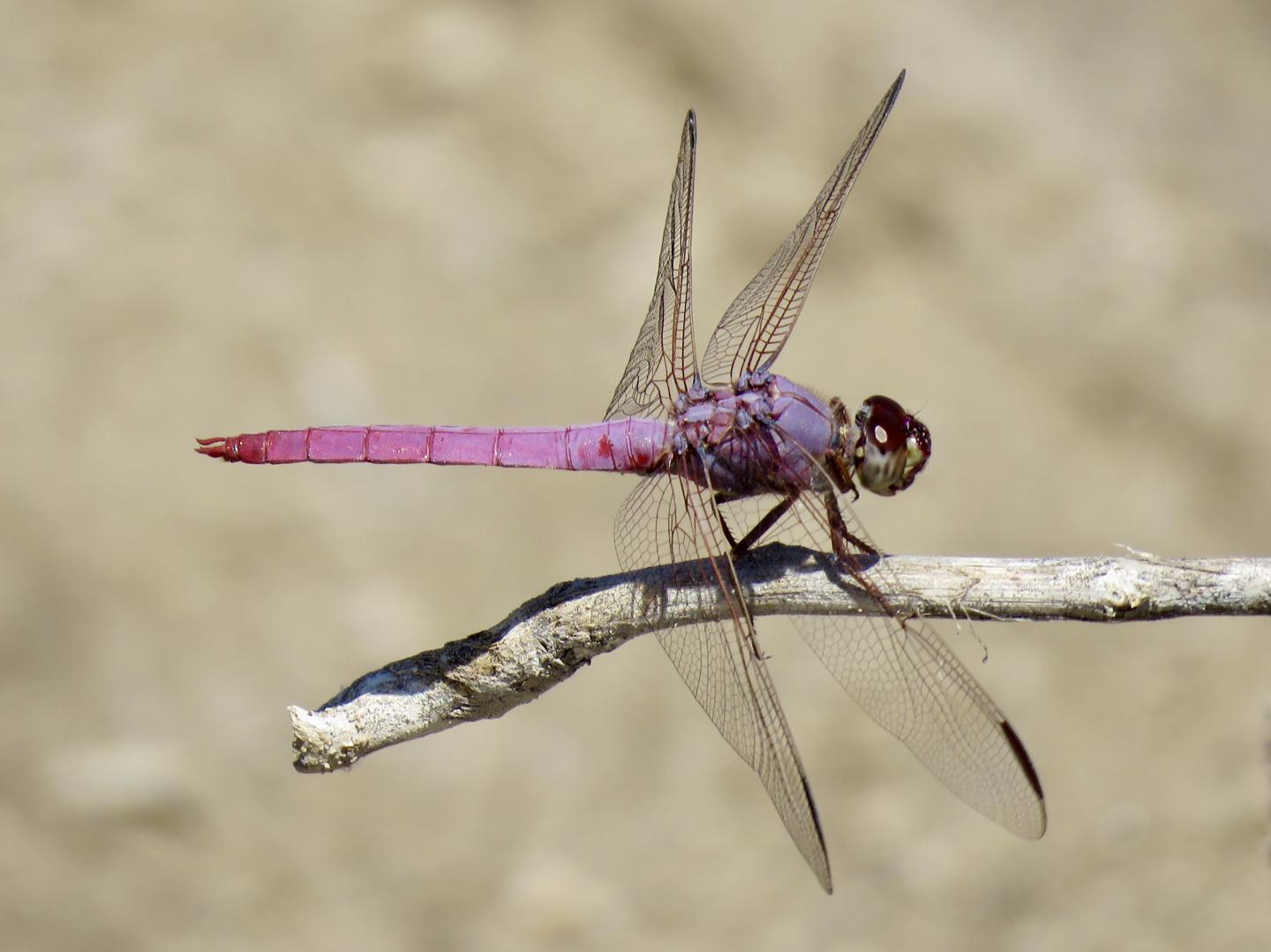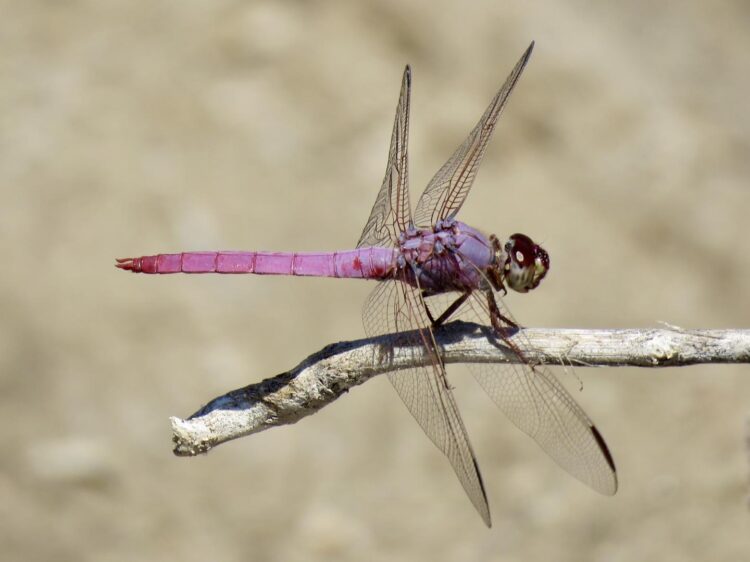Dragonflies, mayflies and caddisflies may be small, but their appearance could signal a big comeback for the beleaguered rivers of the American Southwest

Credit: Courtesy of Michael Bogan
Throughout the late 19th century, rivers across the southwestern United States were parceled out, and flows were diverted through irrigation canals and trapped behind dams. Growing populations put new demands on groundwater sources. Coupled with changing climate conditions, water tables sank and perennial streams began to run dry.
The fate of the Santa Cruz River in southeastern Arizona was no different.
The banks of the river, described in 1855 by explorer Julius Froebel as “covered with poplars and willows, ash-trees and plantains, oaks and walnut trees,” would be unrecognizable by the late 1940s.
Nearly 70 years after the historic downtown reach of the Santa Cruz River ran dry, water returned in the form of 2.8 million gallons of reclaimed water released daily through the city of Tucson’s Santa Cruz River Heritage Project.
When the water valves opened, researchers from the University of Arizona School of Natural Resources and the Environment were there to witness the occasion. Their driving question: When and how would the aquatic biodiversity return?
“Within the first day, we saw seven different species of dragonflies,” said Michael Bogan, an assistant professor of natural resources with the College of Agriculture and Life Sciences.
After 10 months, the team found over 40 species.
“Which is what you would see in a site that had been flowing for a very long time,” Bogan said.
More than a year of effluent-fed river flow later, the results of the “grand experiment” – published this week in the environmental science-focused, open-access journal PeerJ – are simple: Just add water.
“If you can put water back into these river systems that have been essentially de-watered, aquatic life will respond,” Bogan said. “It will come back, even after a long absence, as is the case with the river in downtown Tucson.”
The Good, the Bad and the Stinky:
Historically, effluent-dependent streams have been widely seen as degraded ecosystems, with much lower biodiversity than natural streams.
“This was due to relatively poor water quality being discharged into streams from wastewater treatment facilities,” said Hamdhani, a graduate student in the School of Natural Resources and the Environment.
Hamdhani led a review study of water quality in effluent-fed streams across the globe, recently published in the journal Freshwater Biology.
“It revealed that some critical water quality parameters are often negatively impacted in portions of streams, typically closest to the effluent outfalls,” Hamdhani said. “Some common issues include elevated temperature, nutrients, trace organic contaminants and low dissolved oxygen.”
However, many wastewater treatment plants have been upgraded to provide better reclaimed water quality, and this better water is now supporting surprisingly high levels of biodiversity, as is the case in the Santa Cruz River.
“A lot of that is due to changes that the county made about eight years ago to both of the treatment plants that feed the northern reaches of the river,” Bogan said. “Prior to 2012, they discharged lower quality water. You used to be able to smell the river when you drove in on I-10.”
Both treatment plants went through a major upgrade in the early 2010s, where they improved the water treatment process.
“After that, the smell disappeared,” Bogan said. “And biodiversity returned.”
Crossing the Border, Changing Directions:
The Santa Cruz River, a tributary of the Gila River, runs approximately 184 miles. It springs from the grasslands of the San Rafael Valley east of Patagonia, Arizona, and is the only river in the U.S. to cross the border twice. Running south into Mexico for roughly 10 miles, it changes course and turns north to cross the border again just east of Nogales.
“The river channel flows all the way to the confluence of the Gila River south of the Phoenix area,” said Drew Eppehimer, a doctoral student in arid lands resource sciences. “Traditionally, it never really flowed that far. Maybe in huge monsoon flood events, but the formerly perennial sections of the river, here near town, dried up in the early 1900s because of groundwater pumping.”
Eppehimer studies water management along the borderlands, focused particularly on treated effluent-fed streams and river systems as a potential source of novel habitats for aquatic life in the desert.
In Arizona, there are about a dozen effluent-dependent river and stream systems, making up about 90 miles of effluent flow.
Reclaimed water released from two wastewater treatment plants just north of Tucson helps the Santa Cruz flow as far as the Pinal County line. Beginning in 2017, Eppehimer delved into the at-times waist-deep waters in these northern reaches of the Santa Cruz River to study the resurgence of aquatic life taking root.
“There wasn’t a lot of historical research on that reach of the river, but there was some. When you look at what they found, they would see a handful of insects, five or 10 different kinds,” Bogan said. “Whereas Drew went out there and found over 150 different kinds. That’s all thanks to the upgrade of these treatment plants and the higher water quality that we have now.”
“Mayflies and caddisflies are quite abundant in that part of the river, which kind of shocked us,” Eppehimer said. “You think of this effluent as maybe being of poorer quality than a natural stream system, and a lot of other studies view treated wastewater as a detriment to aquatic environments, but here it’s the only water we have that sustains year-round flows in the river.”
The biodiversity in the northern reaches of the effluent-dependent Santa Cruz River are encouraging; caddisflies and mayflies are not only indicators of a fairly healthy water system, but signs of a comeback, according to the researchers.
New Reaches, New Beginnings:
The new Santa Cruz River Heritage Project is a third discharge location along the river near Tucson, south of downtown and farther upstream. Eppehimer’s findings in the northern reaches of the river served as the baseline for additional research.
“The downtown reach gave us that opportunity to say, OK, from day one, who arrives first, which species do well, and how long does it take for that same level of biodiversity that we see in the northern reaches to build up in this new reach? In the case of the dragonfly, it actually became that best case scenario within a year,” Bogan said.
Innovative new projects using effluent to restore flow in rivers, like the Santa Cruz River Heritage Project, are showing almost immediate positive biodiversity effects, and the return of species to these rivers after very long dry spells can be incredibly fast.
Still, questions remain. Despite improved wastewater treatment technologies, trace levels of contaminants, such as per- and polyfluoroalkyl substances and pharmaceuticals, pass through treatment and persist in streams.
“Further questions surround the things we cannot readily observe, or those mixtures of environmentally persistent compounds that are not yet regulated and slip by treatment processes,” said David Walker, an assistant research scientist in the UArizona Department of Environmental Science.
Walker adds that these compounds may have cumulative biological and behavioral effects on organisms and aquatic life, and says it is often the mixture of these micropollutants in treated effluent discharged into rivers that account for the biggest unknowns.
“Effluent can potentially still pose water quality impairments that may cause biological community degradation,” Hamdhani said. “However, when wastewater treatment standards are high, effluent-fed streams can serve as refuges for aquatic biodiversity and corridors of ecological connectivity, especially in semi-arid and arid regions where natural streams have been depleted.”
###
Media Contact
Rosemary Brandt
[email protected]
Original Source
https:/
Related Journal Article
http://dx.





